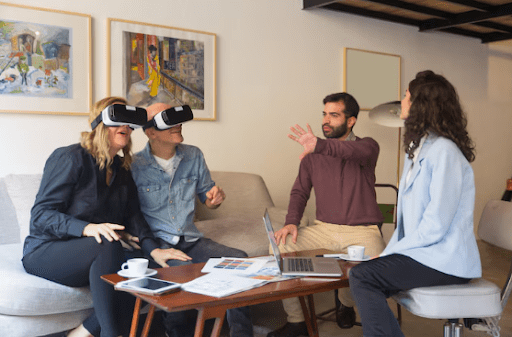Augmented Reality vs Virtual Reality: Key Differences, Use-Cases, and Market Trends

In the contemporary and rapidly changing space of immersive technology, Augmented Reality (AR) and Virtual Reality (VR) have emerged as powerful forces that are dramatically changing the industries they enter. Both are directed at improving the user experience, but they do so in fundamentally different ways, and it is important to understand the myriad unique features and possibilities of each.
Exploring Augmented Reality examples will illustrate the method and suggest how AR is being applied across industries, including retail, education, medical, and entertainment. Investigation of such real-world applications will allow business and consumers to differentiate, realize opportunities, and better understand what trends are emerging and how they shape the future of immersive technology.
Definitions of Augmented Reality (AR) and Virtual Reality (VR)
AR: Augmented Reality adds digital elements (e.g., images, videos, sounds, and data) to the physical world to enhance a user’s experience and interaction with what they are experiencing. While it does not fully immerse users in a digital experience, it allows them to engage in and interact with digital and physical realities simultaneously. For example, AR and navigation can provide listed directions for travel on a live view of a street; a demo of a product in a retail setting can project an interactive experience; or a textbook can come alive with models in 3-dimensions as it is read with an AR viewer. By allowing the user to blend digital content into the real-world context in which they are learning/using the digital content, AR provides users opportunities for interactions in learning, productivity, or entertainment.
VR: Virtual Reality is more of an immersive experience because it can completely replace the physical world around the user with a digital space, often with the use of a headset, motion controllers, or other forms of equipment. VR provides the opportunity for scenarios that could not or would not happen in real life, such as on other planets, simulations of performing surgical procedures to completely immerse the learner, or the learning could include realistic and interactive training scenarios that can happen in a social or professional context. The fully immersive experience with sensory elements makes VR impactful for formatting the experience for gaming, virtual tours, storytelling, or professional learning and development in general, as well as learning and development in various fields such as healthcare, architecture, and engineering.
Different Uses in Various Industries
- Healthcare:
AR allows the surgeon to see the data he wants in real-time on top of everything else. VR is used to train medical professionals in simulated environments that practice risky surgical procedures.
- Education:
AR makes learning materials in interactive ways, making difficult subjects something to engage in. VR provides immersive learning experiences so students can virtually experience history or science experiments first-hand.
- Retail
AR helps the customer visualize the product in their own location before purchasing the customer. VR creates a virtual shopping experience where consumers can shop for products while inside their home and possibly never see the product in person.
- Manufacturing and Maintenance:
AR allows technicians to get real-time hands-free assistance, improving process speed and reducing errors. VR provides training on operating complex machinery without needing to use physical equipment.
- Entertainment and Gaming:
The AR game Pokémon GO has players walking around the real world catching Pokémon and searching for things. VR games provide fully immersive gaming worlds and experiences while interacting and engaging the player.
Market Trends and Future Directions
Augmented Reality (AR):
The AR industry continues on a fast growth path and is worth more than $50 billion by 2025. The growth of AR is propelled by advancements in hardware, looking as AR-enabled smart glasses, smartphones, and AR software platforms. The retail, health, education, and manufacturing sectors are looking closely at AR solutions as they relate to being a better customer experience, working more efficiently, and using AR to create interactive learning or training experiences. AR can be broadly defined as an overlay of digital content in the real-world context (for example, e-commerce virtual try-on technologies). It can also be described as immersive simulation technologies in therapeutic health-care contexts. The growth in AR has it on a trajectory where it is becoming a true disruptor across industries.
Virtual Reality (VR):
Likewise, VR is an industry that expands steadily, and the number of active VR users is also anticipated to reach 216 million worldwide by 2025. This growth is driven by making VR headsets more accessible in both cost and availability; younger generations are simply more interested in VR technologies in general, in areas such as VR games, virtual tours, and experiences in professional training. The VR industry continues to expand in versatility and different comprehensive professional experiences; for example, VR technologies are being used for simulations in therapeutic health-care contexts, and even in educational settings, among many other sectors.
Challenges and Considerations
Physical Requirements:
Both AR and VR rely on specialized hardware, which is often pricey and therefore not available to all users for every service. Developing cheaper, lightweight devices is an important step for broader adoption.
User Experience:
Creating a seamless, comfortable user experience is important. VR motion sickness and device fatigue in AR can interfere with user engagement.
Privacy and Data Protection:
The collection and processing of user data in AR and VR applications is one of the biggest privacy challenges. It is crucial to have protocols around data protection in place to retain user confidence.
Conclusion
Augmented Reality (AR) and Virtual Reality (VR) are transforming the way we perceive, recognize, and experience the world. AR adds digital layers on top of our reality to improve our experience with it, and VR places the user in a simulated world away from the reality outside. Both technologies promise the potential to engage, streamline, and innovate across verticals such as retail, education, healthcare, entertainment, and industrial use cases.
With continued advancements in hardware and software, AR and VR will proliferate their relevance in our everyday experience than we can appreciate. The leading brands like Flam are at the forefront of this change by creating exciting tools that democratize the use of immersive technology across all businesses. Flam empowers companies to engage audiences with AR-powered interactive experiences, from VR-powered training or simulation learning experiences. Flam’s approach will engage audiences by solving access, cost, and content challenges; AR and VR are about to change human interaction increasingly with the digital and physical worlds, creating opportunities for businesses, consumers, and society in new ways.

Source: Augmented Reality vs Virtual Reality: Key Differences, Use-Cases, and Market Trends



